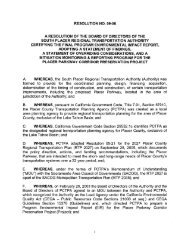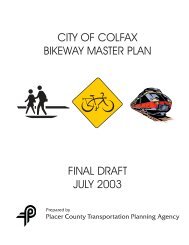Bus Rapid Transit (BRT) Implementation Study for South ... - pctpa
Bus Rapid Transit (BRT) Implementation Study for South ... - pctpa
Bus Rapid Transit (BRT) Implementation Study for South ... - pctpa
Create successful ePaper yourself
Turn your PDF publications into a flip-book with our unique Google optimized e-Paper software.
<strong>Bus</strong> <strong>Rapid</strong> <strong>Transit</strong> (<strong>BRT</strong>) <strong>Implementation</strong> <strong>Study</strong> <strong>for</strong> south Placer CountySeptember 8, 2006The significant increase in transit mode share that occurs when densities are greater than 10,000 persons persquare mile is related to average residential dwelling unit densities greater than six units per acre. Thisanalysis also showed that bicycle and walk had a larger share than transit at all density levels.Holtzclaw et al’s recent (2002) study confirms numerous studies by Holtzclaw and others that a doubling indensity results in a 25 percent reduction in vehicle miles traveled (vmt). Only a fraction of this reduction isdue to more transit use and Holtzclaw’s principle data source (e.g., Department of Motor Vehicles odometerchecks) makes transit’s specific contribution difficult to ascertain.Cali<strong>for</strong>nia Specific DataThe 1990 U.S. Census found that 17.8 percent of the total work trips by those living within 1/2 mile of a BARTstation were made on BART (Cervero, 1993). In a survey of station area adult residents living in 11multifamily, mainly rental, housing developments near BART (all but three within one-third mile of BARTstation), Cervero found a higher BART work mode split of 33 percent in the early 1990s.Cervero also studied the effect of proximity to LRT on mode choice in Sacramento. He surveyed residents offour apartment complexes near (generally less than ½ mile walking distance) Sacramento’s LRT and foundthat 12 percent of residents “main trips” (as defined by respondents) were by rail; another 3.2 percent were bybus transit (Cervero, 1993, p. 43). Looking at employment sites in suburban Sacramento that were alsowithin easy walking distance of LRT stations, he found that 6.3 percent of workers arrived by rail and another5.4 percent by bus (ibid, p. 80). It should be noted that while both the apartments and the worksites studiedby Cervero were outside downtown, they were larger and more intensely developed than most suburbandevelopments in the region.A later study using year 2000 Bay Area Travel Survey (BATS) (Cervero and Duncan 2002, p. 12) found that19.6 percent of residents living within 1/2 mile of BART commuted via transit in that year. This is slightlyhigher than the 1990 Census BART mode split <strong>for</strong> workers within the 1/2-mile radius (17.8 percent). Thissuggests that the proximity effects of rail are not too different from when Cervero conducted his earlier study.Employment IntensityA complementary issue that is often overlooked in studies of the land use and transit connection is that of thecommercial densities required to support transit use. Non-residential densities are often referred to as“intensities” and can be expressed in terms of total square footage, total employment, employment density, orfloor area ratio (FAR). Frank and Pivo (1995) found employment densities to be as or more important thanresidential densities. Using Seattle-area data, they found that bus transit ridership to employment centersrises to about 10 percent of all work trips when there are about 100 employees/acre, and exceeds 33 percentwhen employment densities exceed 200/acre. Dill (2003) studied the land use effects on rail ridership in theBay Area at the work end using large-scale employer-based surveys conducted in the early 1990s. Datawere obtained <strong>for</strong> BART station area employers as well as Caltrain and Santa Clara light rail (Valley <strong>Transit</strong>Authority or VTA) station area employers. Employers not near rail serve as a comparison group. The results18





